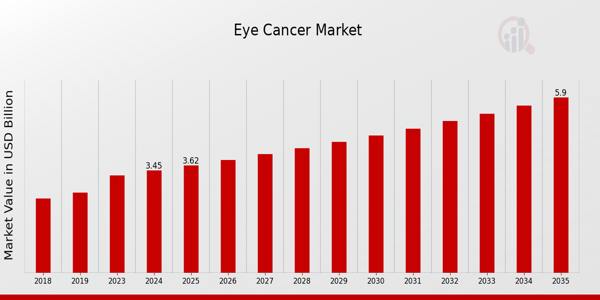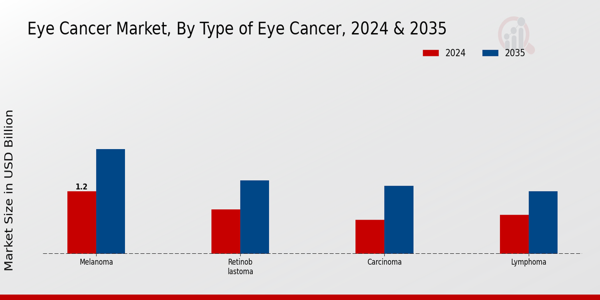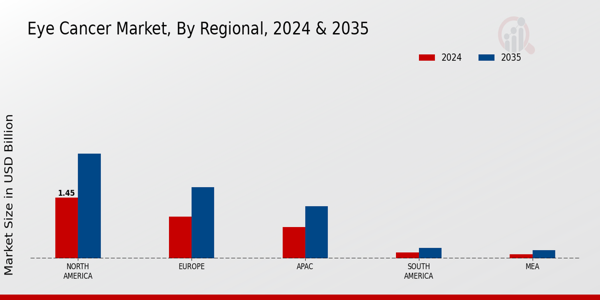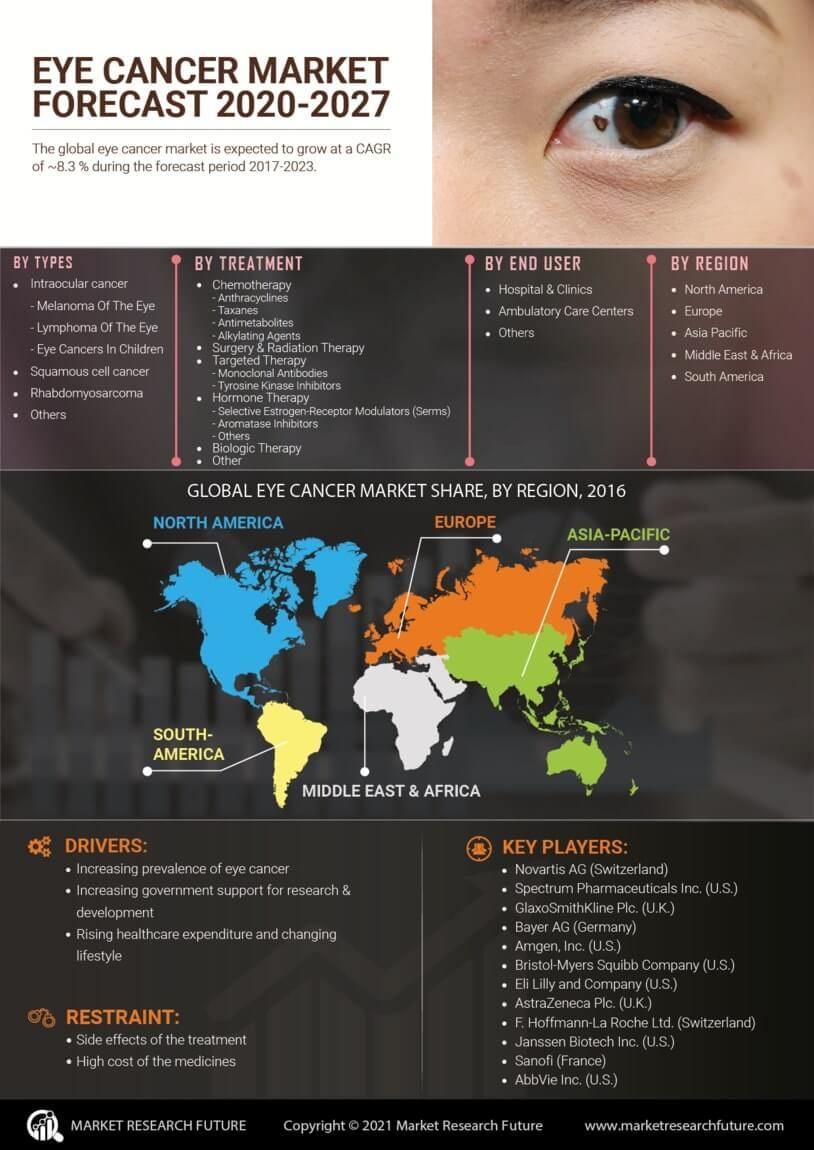Eye Cancer Market Overview
As per MRFR analysis, the Eye Cancer Market Size was estimated at 3.28 (USD Billion) in 2023. The Eye Cancer Market Industry is expected to grow from 3.45(USD Billion) in 2024 to 5.9 (USD Billion) by 2035. The Eye Cancer Market CAGR (growth rate) is expected to be around 5.01% during the forecast period (2025 - 2035).
Key Eye Cancer Market Trends Highlighted
The Global Eye Cancer Market is witnessing significant trends driven by increasing awareness of eye diseases and advancements in treatment options. A key market driver is the rising incidence of eye cancers, which has prompted healthcare systems and organizations worldwide to focus on early detection and treatment. Enhanced imaging technologies and diagnostic techniques are enabling more accurate and earlier diagnosis of conditions like retinoblastoma and melanoma, thus driving demand for innovative therapies. Additionally, the increasing number of clinical trials and research initiatives globally is pushing forward the development of new treatment modalities, including targeted therapies and immunotherapies.
Opportunities in the Global Eye Cancer Market are emerging from the growing focus on personalized medicine and gene therapy. These advancements offer the potential for tailored treatment plans based on individual patient genetics, promising improved outcomes for patients. Additionally, as telemedicine gains traction, patients in remote areas are gaining better access to specialists and treatment options, thus expanding the market further. Trends in recent times highlight a shift toward multidisciplinary approaches in managing eye cancer.
Collaboration between oncologists, ophthalmologists, and radiation specialists is becoming increasingly common, reflecting a holistic view of patient care.Large-scale awareness campaigns and educational programs aimed at both healthcare professionals and the general public are also contributing to improved detection and treatment rates. Furthermore, global health initiatives emphasizing the importance of regular eye check-ups are enhancing the response to eye cancers, ensuring that more patients are diagnosed and treated promptly, which is crucial for positive patient outcomes.

Source: Primary Research, Secondary Research, Market Research Future Database and Analyst Review
Eye Cancer Market Drivers
Increasing Incidence of Eye Cancer
The rising prevalence of eye cancer globally is driving considerable growth in the global eye cancer market industry. The World Health Organization reports that the incidence of eye cancer has been continuously increasing, with estimates indicating that the number of cases has climbed by around 28% over the past ten years, impacting over 400,000 people annually worldwide. Lifestyle decisions and environmental UV radiation exposure are some of the reasons contributing to this growth. The industry is expanding as a result of organizations like the American Cancer Society aggressively encouraging early detection and awareness.
Due to this increase in instances, healthcare organizations' concerns will cause a greater emphasis on treatment alternatives and advancements in the years to come.
Advancements in Treatment Modalities
Technological advancements in treatment modalities are also propelling growth in the Global Eye Cancer Market Industry. Innovative therapies such as targeted therapies and immunotherapy are becoming more prevalent, and clinical trials are revealing promising results. Research institutions like the National Cancer Institute have reported a substantial increase in funding for eye cancer research, with funding exceeding USD 350 million in the last fiscal year alone.These advancements not only improve patient outcomes but also offer new revenue streams for pharmaceutical companies. As these new treatments gain regulatory approval, they are expected to drive significant market expansion.
Growing Public Awareness and Education
Public awareness regarding eye cancer is on the rise, driven by campaigns from non-profit organizations and health agencies worldwide. The Global Eye Cancer Market Industry benefits from increased educational efforts that aim to inform individuals about the dangerous signs of eye cancer. Various health bodies have noted a 40% increase in public engagement in eye health awareness programs compared to five years ago.
Moreover, initiatives spearheaded by organizations like the International Agency for the Prevention of Blindness have heightened awareness about the importance of early detection.This increasing awareness encourages individuals to seek medical advice at earlier stages of the disease, thus fostering demand for diagnostic and therapeutic services, thereby fueling market growth.
Policy Support and Funding for Eye Cancer Research
Government policies and funding focused on cancer research significantly bolster the Global Eye Cancer Market Industry. Several nations are now recognizing the need to combat various forms of cancer, including eye cancer, through policy reforms and financial allocations. For instance, the National Health Institute announced a 20% increase in funding for eye cancer research initiatives aimed at early detection and patient care advancements.
This investment not only supports local research but also fosters international collaboration, facilitating innovations that can improve treatment efficacy and broaden market opportunities.As governments worldwide prioritize healthcare expenditures and cancer management strategies, the eye cancer segment stands to benefit enormously.
Eye Cancer Market Segment Insights
Eye Cancer Market Type of Eye Cancer Insights
The Global Eye Cancer Market is witnessing significant developments, reflecting a growing awareness and advancements in treatment options. The market is valued at 3.45 USD Billion in 2024 and is projected to reach 5.9 USD Billion in 2035, highlighting a steady growth trajectory within the industry. The segmentation of the Global Eye Cancer Market by Type of Eye Cancer reveals crucial insights into the various categories and their respective market valuations. Specifically, Retinoblastoma, which is notably concerning in pediatric populations, accounted for a value of 0.85 USD Billion in 2024 and is expected to reach 1.4 USD Billion by 2035.
This rising valuation demonstrates the importance of early detection and treatment, as Retinoblastoma can severely impact young patients' vision and overall health. Melanoma emerges as another significant contributor to the market, holding a valuation of 1.2 USD Billion in 2024, which is forecasted to grow to 2.0 USD Billion by 2035. Given that melanoma of the eye can spread rapidly if not treated promptly, its rising valuation indicates robust demand for effective treatment options and increased awareness regarding this malignant form of cancer.
Lymphoma, particularly primary intraocular lymphoma, is also part of the market's composition, with a current valuation of 0.75 USD Billion expected to rise to 1.2 USD Billion by 2035.
This cancer type requires targeted therapies that are bolstered by intensive research aimed at improving patient outcomes. Carcinoma, while generally less common compared to the aforementioned types, has a valuation standing at 0.65 USD Billion and is projected to grow to 1.3 USD Billion by the same year. This form of eye cancer, although less prevalent, nonetheless necessitates ongoing research and advancements in treatment options, reflecting the importance of comprehensive healthcare initiatives.The Global Eye Cancer Market segmentation provides substantial data that underscores the diverse types of eye cancer and their specific treatment needs.
The growth factors driving this market include increased awareness among healthcare providers and patients, advancements in technology, and investment in Research and Development initiatives. Additionally, the significant valuations of these eye cancer types underscore their impact in the real world, with Retinoblastoma and Melanoma holding majority shares and dominating the market landscape. The comprehensive understanding of the different types of eye cancer through the Global Eye Cancer Market Statistics illustrates not only the existing challenges but also the opportunities that lie ahead in addressing these malignancies effectively.

Source: Primary Research, Secondary Research, Market Research Future Database and Analyst Review
Eye Cancer Market Diagnosis Method Insights
In the Global Eye Cancer Market, the Diagnosis Method segment plays a crucial role in enhancing patient outcomes and facilitating timely interventions. In 2024, the market is valued at 3.45 billion USD, reflecting the growing demand for advanced diagnostic techniques. The segment comprises various methods such as Optical Coherence Tomography, Ultrasound, CT Scan, and MRI, each contributing uniquely to diagnosis accuracy and patient management. Optical Coherence Tomography is particularly beneficial, providing high-resolution images that aid in the early detection of eye tumors.
Ultrasound remains a staple for its efficiency and non-invasive nature, capturing real-time data that is invaluable in identifying tumor characteristics. CT Scans and MRIs are significant for their ability to deliver comprehensive insights regarding the tumor's size and location, thus informing treatment plans. The integration of these diagnostic tools is essential for ensuring effective screening programs, with a focus on improving Global Eye Cancer Market statistics while addressing prevailing challenges such as accessibility and affordability of diagnostic services.Overall, the continual advancements in these technologies are poised to propel market growth in the diagnosis of eye cancer across the globe.
Eye Cancer Market Treatment Type Insights
The Global Eye Cancer Market has shown significant growth in its Treatment Type segment, reflecting the rising need for effective therapeutic options. In 2024, the market is valued at 3.45 billion USD, with the Treatment Type category playing a pivotal role in this landscape. Various types of treatments, including Radiation Therapy, Chemotherapy, Surgery, and Immunotherapy, are vital in managing eye cancer effectively. Radiation Therapy is crucial for targeting and shrinking tumors, while Chemotherapy has been integral in managing systemic symptoms.Surgery remains a cornerstone treatment, especially for localized eye tumors, ensuring complete tumor removal when feasible.
Immunotherapy is emerging as a promising approach, enhancing the body’s immune response against cancer cells, which is increasingly recognized for its potential in advanced cases. The Global Eye Cancer Market segmentation highlights the importance of diverse treatment modalities, addressing the different needs of patients and providing healthcare professionals with a comprehensive toolkit for treatment. With increasing investment in Research and Development and advancements in technology, the market is well-positioned to continue its growth trajectory, catering to the global population's healthcare demands and improving patient outcomes.
Eye Cancer Market End User Insights
The Global Eye Cancer Market has observed significant developments in recent years, with avaluation of 3.45 USD Billion by 2024. This growth is largely attributed to the rising incidence of eye cancers and the growing need for advanced treatment options. The End User segment of this market includes Hospitals, Oncology Clinics, and Research Institutions, each playing a crucial role in patient care and medical advancement.
Hospitals are central to the provision of comprehensive cancer treatment, catering to a wide range of patients and allowing for multidisciplinary approaches.Oncology Clinics focus on specialized care, offering targeted therapies and clinical trials, which are vital for innovation in treatment protocols.
Research Institutions contribute to the Global Eye Cancer Market by facilitating essential Research and Development efforts aimed at discovering new therapies and better understanding the pathology of eye cancers. The increasing investment in healthcare infrastructure and the emphasis on early diagnosis and treatment methodologies present significant opportunities within this segment, further driving the growth trajectory of the market.As the landscape of eye cancer diagnosis and treatment evolves, these End Users will continue to be integral to enhancing outcomes for patients globally.
Eye Cancer Market Regional Insights
The Global Eye Cancer Market is expected to see varying valuations across its regional segments, highlighting the market's distinct characteristics and growth potential. North America is projected to dominate this landscape, with a valuation of 1.45 USD Billion in 2024 and expected to reach 2.5 USD Billion by 2035, showcasing the region's majority holding driven by advanced healthcare infrastructure and increased awareness.
Europe follows closely, with estimations of 1.0 USD Billion in 2024 and growing to 1.7 USD Billion by 2035, attributed to strong Research and Development investments and comprehensive healthcare policies.The Asia-Pacific (APAC) region, valued at 0.75 USD Billion in 2024, is on a growth trajectory, estimated to reach 1.25 USD Billion by 2035, benefiting from rising healthcare access and population awareness.
South America shows a modest valuation of 0.15 USD Billion in 2024, growing to 0.25 USD Billion by 2035, indicating potential opportunities in healthcare advancements but still lagging in market size. Lastly, the Middle East and Africa (MEA) region accounts for 0.1 USD Billion in 2024 and is expected to grow to 0.2 USD Billion by 2035.
The relatively lower market size reflects challenges such as limited healthcare resources and awareness but also presents significant opportunities for market entrants aiming to improve eye cancer care in these regions.Overall, the regional segmentation of the Global Eye Cancer Market underscores varying depths of healthcare development and investment opportunities across the globe.

Source: Primary Research, Secondary Research, Market Research Future Database and Analyst Review
Eye Cancer Market Key Players and Competitive Insights
The Global Eye Cancer Market is evolving rapidly, driven by increasing awareness of ocular malignancies and advancements in treatment options. This market is characterized by a competitive landscape featuring a variety of players ranging from well-established pharmaceutical giants to emerging biotech companies. As the prevalence of eye cancer continues to rise, companies are focusing on innovation and developing targeted therapies that aim to improve patient outcomes.
The competitive insights within this market reveal that firms are not only working on cutting-edge technologies but are also engaging in strategic collaborations and partnerships to accelerate drug development processes and expand their market reach.
Companies are increasingly investing in research and development activities tailored to address the unmet needs of patients suffering from ocular tumors, thereby fostering an environment of heightened competition and innovation.In the context of the Global Eye Cancer Market, Genentech has established a prominent presence, leveraging its extensive portfolio of targeted therapies and monoclonal antibodies. The company's focus on precision medicine has allowed it to offer tailored treatment options for various eye cancer types, thus enhancing its reputation as a leader in the field.
Genentech's strong research and development capabilities are complemented by its commitment to understanding the underlying biology of ocular malignancies.
The company's strengths lie in its ability to provide innovative solutions that not only improve clinical outcomes but also enhance the quality of life for patients. Additionally, Genentech has a well-equipped distribution network and partnerships with healthcare institutions, which facilitate the timely delivery of its treatments to patients across global markets.Pfizer is another notable player in the Global Eye Cancer Market, renowned for its comprehensive portfolio of oncology products and its focus on developing effective therapies for various forms of cancer.
The company's key offerings in the eye cancer segment demonstrate its commitment to addressing the complex needs of patients diagnosed with ocular cancers. Pfizer's strengths include its robust research and development infrastructure, which allows for swift adaptation to emerging treatment modalities and changing market dynamics. The company's strategic mergers and acquisitions have bolstered its capabilities and expanded its reach in the global market, enabling it to deliver innovative therapies that are aligned with current treatment paradigms.
With a strong focus on global outreach, Pfizer continues to invest in initiatives that enhance accessibility and equity in healthcare for patients around the world, further solidifying its position in the competitive landscape of the eye cancer market.
Key Companies in the Eye Cancer Market Include
- Regeneron Pharmaceuticals
Eye Cancer Market Industry Developments
The Global Eye Cancer Market has recently witnessed significant developments, particularly concerning the advancements in therapies and treatments. Genentech and Roche are actively collaborating to enhance targeted therapies for ocular melanoma, focusing on innovative treatments that utilize cancer immunotherapy. Pfizer has announced an expansion in its Research and Development initiatives aimed at developing novel ocular cancer therapies in response to increasing patient needs. Meanwhile, Bausch Health has made strides in introducing new diagnostic tools to facilitate early detection of eye cancer, reinforcing its commitment to improving patient outcomes.
In terms of market valuation, companies like Novartis and Regeneron Pharmaceuticals have reported notable growth, driven by increased investments in ocular disease research, which is positively impacting the overall market landscape. Notably, in August 2023, Merck acquired a promising biotech company specializing in retinal disease therapies, enhancing its portfolio in the eye cancer segment. In the past few years, significant advancements in gene therapy applications have been observed, which have transformed the treatment approaches and broadened the capabilities of existing therapies in the Global Eye Cancer Market.
Eye Cancer Market Segmentation Insights
Eye Cancer Market Type of Eye Cancer Outlook
Eye Cancer Market Diagnosis Method Outlook
- Optical Coherence Tomography
Eye Cancer Market Treatment Type Outlook
Eye Cancer Market End User Outlook
Eye Cancer Market Regional Outlook
| Report Attribute/Metric Source: |
Details |
| MARKET SIZE 2023 |
3.28(USD Billion) |
| MARKET SIZE 2024 |
3.45(USD Billion) |
| MARKET SIZE 2035 |
5.9(USD Billion) |
| COMPOUND ANNUAL GROWTH RATE (CAGR) |
5.01% (2025 - 2035) |
| REPORT COVERAGE |
Revenue Forecast, Competitive Landscape, Growth Factors, and Trends |
| BASE YEAR |
2024 |
| MARKET FORECAST PERIOD |
2025 - 2035 |
| HISTORICAL DATA |
2019 - 2024 |
| MARKET FORECAST UNITS |
USD Billion |
| KEY COMPANIES PROFILED |
Genentech, Pfizer, Roche, Eli Lilly, Bausch Health, Santen Pharmaceutical, Eisai, Novartis, Regeneron Pharmaceuticals, Bayer, BristolMyers Squibb, Merck, AstraZeneca, Amgen |
| SEGMENTS COVERED |
Type of Eye Cancer, Diagnosis Method, Treatment Type, End User, Regional |
| KEY MARKET OPPORTUNITIES |
Rising prevalence of eye cancer, Advancements in treatment technologies, Increased awareness and early diagnosis, Growing geriatric population, Expanding research and clinical trials |
| KEY MARKET DYNAMICS |
Increasing prevalence of eye cancer, Growing awareness and screening initiatives, Advancements in treatment technologies, Rising investment in research, Aging population and genetic factors |
| COUNTRIES COVERED |
North America, Europe, APAC, South America, MEA |
Eye Cancer Market Highlights:
Frequently Asked Questions (FAQ):
The Global Eye Cancer Market is expected to be valued at 3.45 billion USD in 2024.
By 2035, the Global Eye Cancer Market is anticipated to reach a value of 5.9 billion USD.
The expected CAGR for the Global Eye Cancer Market from 2025 to 2035 is 5.01%.
North America is expected to dominate the Global Eye Cancer Market with a value of 2.5 billion USD by 2035.
The Melanoma segment of the Global Eye Cancer Market is projected to be valued at 2.0 billion USD by 2035.
Key players in the Global Eye Cancer Market include Genentech, Pfizer, Roche, Eli Lilly, and Bausch Health.
The North American segment of the Global Eye Cancer Market is valued at 1.45 billion USD in 2024.
The Retinoblastoma segment is expected to be valued at 1.4 billion USD in the Global Eye Cancer Market by 2035.
The Global Eye Cancer Market faces challenges such as high treatment costs and limited awareness, impacting growth.
In 2024, the Lymphoma segment of the Global Eye Cancer Market is expected to be valued at 0.75 billion USD.


















